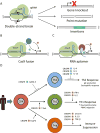CRISPR/Cas9 in allergic and immunologic diseases
- PMID: 27687572
- PMCID: PMC5592636
- DOI: 10.1080/1744666X.2017.1241711
CRISPR/Cas9 in allergic and immunologic diseases
Keywords: CRISPR/Cas9; allergic disease; gene editing; gene regulation; immunologic disease.
Figures

References
-
- Horvath P, Barrangou R. CRISPR/Cas, the Immune System of Bacteria and Archaea. Science. 2010;327(5962):167–170. - PubMed
Publication types
MeSH terms
Substances
Grants and funding
LinkOut - more resources
Full Text Sources
Other Literature Sources
Medical
